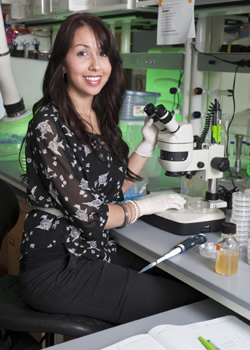 Anastacia Garcia has always loved the outdoors, but little did she know that her passion would lead her to a career in biology.
Anastacia Garcia has always loved the outdoors, but little did she know that her passion would lead her to a career in biology.
It wasn't until she interned at Healthpoint, a pharmaceutical company based in Fort Worth, during her undergraduate studies that she realized she wanted her research to become a career.
"I worked in a cell biology lab culturing human skin cells in order to investigate cell based therapies that promote wound healing and I just fell in love with biology at that point," Garcia said. "From then on, I knew I wanted to research. I wanted to be in a lab. I wanted to figure out things that promote human health and disease treatments."
Now as a Ph.D. student at the University of North Texas, Garcia spends her time doing research in a lab that studies oxygen deprivation in C. elegans, a soil dwelling nematode. The worms are able to survive exposure to anoxia, an extreme form of hypoxia or low oxygen, by entering into a reversible state of suspended animation.
Garcia said it's fascinating for researchers to be able to use this simple model organism to reveal the mechanisms behind their anoxia tolerance because it could lead to further insight about certain conditions that affect humans.
"For example, anoxia is significant in diseases such as ischemia, stroke, and even solid tumor cells which are able to survive in low oxygen environments," she said. "So really understanding the mechanisms behind this survival would be beneficial for a number of different treatments."
Garcia's particular project focuses on how diet affects anoxia survival in the worm. Specifically, she has examined carbohydrates, including glucose and how they affect the worm's survival in anoxia. She has been adding extra glucose and other sugars to their daily diet as part of her experiments.
Much to her surprise, she has discovered that adding glucose does not aid the worm's ability to survive anoxia at all, rather the contrary.
"The data showing that supplementing the worms with dietary glucose suppresses their ability to survive the stress of oxygen deprivation can be important for understanding the relationship between diabetes and ischemia," she said.
Her research findings could impact stroke victims, and diabetics she said. People who suffer strokes experience low-oxygen conditions, which can be detrimental and diabetics are more susceptible to stroke.
"Understanding the mechanisms behind C. elegans anoxia tolerance would be beneficial for patients who suffer these from types of conditions," she said.
When it came time to start researching graduate programs, Garcia's boss and professors told her she should look for labs that are fairly well funded and have a high number of publications. She began looking at UNT, and learned that Dr. Pam Padilla, a UNT faculty member, was a great scientist with a lab conducting some very interesting research.
She contacted Dr. Padilla, which led to a future meeting. The two realized they had several things in common.
"She's also a Hispanic female," Garcia said. "And we're both from New Mexico, so it just kind of worked out. She had a history of being well-funded, her lab has a number of publications, and it really just felt like a good fit, so that's why I chose UNT."
Garcia said the mentors are readily accessible to the students, and the facilities in the new Life Science Complex at UNT are impressive.
"Since our lab space is shared, we also get to interact with students in other labs which is awesome because you're able to share ideas and get feedback," she said. "We're exposed to a number of different model organisms and animals, and so many different ideas and different approaches to study each unique organism. I think that helps to really facilitates research and creativity in general."
Garcia said the lab is a welcoming environment.
"I really think this is neat place to be," she said. "And, since this is such an up and coming University, it's a great opportunity."
In addition to her graduate work, Garcia helped establish a chapter of the Society for the Advancement of Chicanos, Hispanics and Native Americans in Science (SACNAS) at UNT last year. The group has been focused on recruiting students and fundraising efforts. This fall Garcia will give a talk about her research at the national SACNAS conference in San Jose, California.
After Garcia graduates she would like to continue to do research as an industry scientist.

